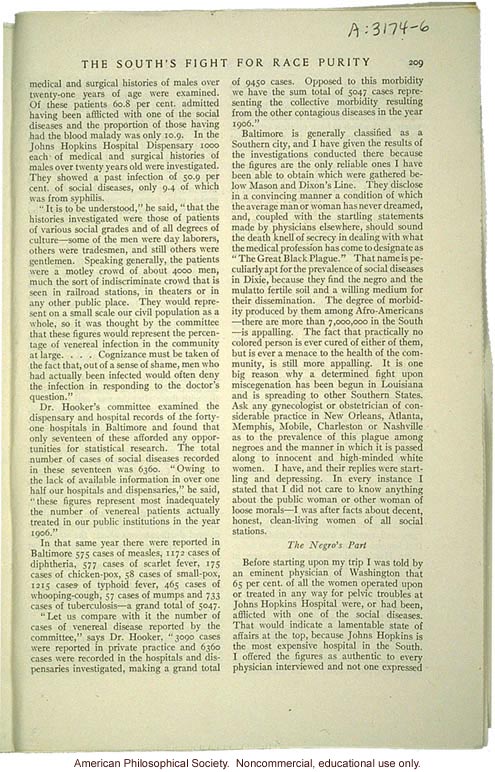The South's Fight for Race Purity 209
medical and surgical histories of males over twenty-one years of age were examined. Of these patients 60.8 per cent admitted having been afflicted with one of the social diseases and the proportion of those having had the blood malady was only 10.9. In the Johns Hopkins Hospital Dispensary 1000 each of medical and surgical histories of males over twenty years old were investigated. They showed a past infection of 50.9 per cent of social diseases, only 9.4 of which was from syphilis.
"It is to be understood," he said, "that the histories investigated were those of patients of various social grades and of all degrees of culture - some of the men were daily laborers, others were tradesmen, and still others were gentlemen. Speaking generally, the patients were a motley crowd of about 4000 men, much the sort of indiscriminate crowd that is seen in railroad stations, in theaters or in any other public place. They would represent on a small scale our civil population as a whole, so it was thought by the committee that these figures would represent the percentage of venereal infection in the community at large ... Cognizance must be taken of the fact that, out of a sense of shame, men who had actually been infected would often deny the infection in responding to the doctor's question."
Dr. Hooker's committee examined the dispensary and hospital records of the forty-one hospitals in Baltimore and found that only seventeen of these afforded any opportunities for statistical research. The total number of cases of social diseases recorded in these seventeen was 6360. "Owing to the lack of available information in over one half of our hospitals and dispensaries," he said, "these figures represent most inadequately the number of venereal patients actually treated in our public institutions in the year 1906."
In the same year there were reported in Baltimore 575 cases of measles, 1172 cases of diphteria, 577 cases of scarlet fever, 175 cases of chicken-pox, 58 cases of small pox, 1215 cases of typhoid fever,465 cases of whooping-cough, 57 cases of mumps and 733 cases of tuberculosis - a grand total of 5047.
"Let us compare with it the number of cases of venereal disease reported by the committee," says Dr. Hooker, "3090 cases were reported in private practice and 6360 cases were recorded in the hospitals and dispensaries investigated, making a grand total of 9450 cases. Opposed to this morbidity we have the sum total of 5047 cases representing the collective morbidity resulting from the other contagious diseases in the year 1906."
Baltimore is generally classified as a Southern city, and I have given the results of the investigations conducted there because the figures are the only reliable ones I have been able to obtain which were gathered below Mason and Dixon's Line. They disclose in a convincing manner a condition of which the average man or woman has never dreamed, and, coupled with the startling statements made by physicians elsewhere, should sound the death knell of secrecy in dealing with what the medical profession has come to designate as "The Great Black Plague." That name is peculiarly apt for the prevalence of social diseases in Dixie, because they find the negro and the mulatto fertile soil and a willing medium for dissemination. The degree of morbidity produced by them among Afro-Americans - there are more than 7,000,000 in the South - is appalling. The fact that practically no colored person is ever cured of either of them, but is ever a menace to the health of the community, is still more appalling. It is one big reason why a determined fight upon miscegenation has begun in Louisiana and is spreading to other Southern States. Ask any gynecologist or obstetrician of considerable practice in New Orleans, Atlanta, Memphis, Mobile, Charleston or Nashville as to the prevalence of this plague among negroes and the manner in which it is passed along to innocent and high-minded white women. I have, and their replies were startling and depressing. In every instance I stated that I did not care to know anything about the public woman or other woman of loose morals - I was after facts about decent, honest, clean-living women of all social stations.
The Negro's Part
Before starting upon my trip I was told by an eminent physician of Washington that 65 per cent of all the women operated upon or treated in any way for pelvic troubles at Johns Hopkins Hospital were, or had been, afflicted with one of the social diseases. That would indicate a lamentable state of affairs at the top, because Johns Hopkins is the most expensive hospital in the South. I offered the figures as authentic to every physician interviewed and not one expressed


